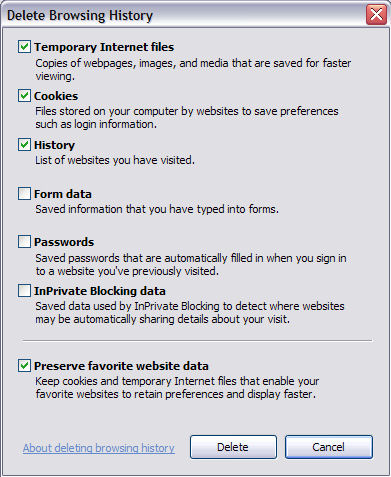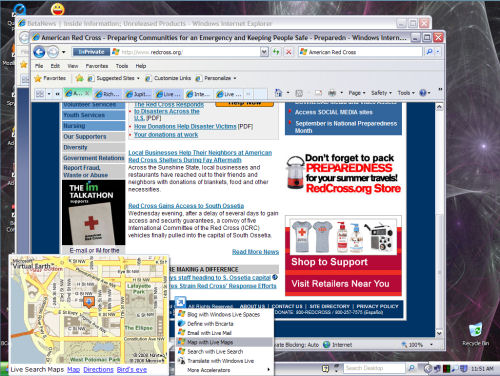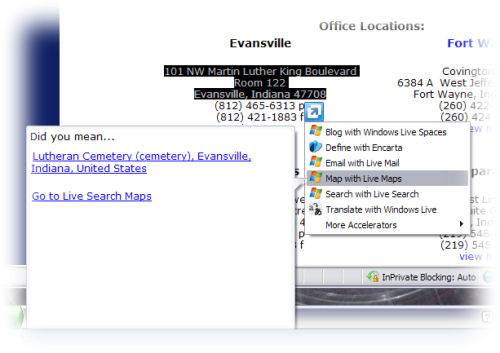Deeper inside IE8 Beta 2
![]()
It's increasingly looking like a whole new browser war is forming, as Microsoft is showing evidence of having re-entered the race to add innovative features to the rapidly aging tool.
Testing a new version of Internet Explorer is almost as important and as detailed as testing a new Windows version, since IE's functionality impacts so many other features of the operating system (not to mention Microsoft Office apps). Microsoft released Beta 2 of Internet Explorer 8 yesterday, and BetaNews is actively testing it now. While we're impressed to find new features, we're uncovering some areas that need work, perhaps for a Beta 3.
One feature which IE6 users asked for during the IE7 beta period, and which finally makes its debut with IE8, is the ability to designate what categories of stored history the browser automatically or manually deletes. This way, when you clear a browser's cache of stored cookies, you don't have to clear stored passwords at the same time.

You reach this dialog box from the familiar Internet Options menu, where there's now a button in the Browsing History frame marked Delete... (with the ellipsis at the end). Here, you'll find something interesting: Apparently by default, IE8 maintains a list of Web sites that appear to be capable of sharing session data with one another, and that list is especially effective with the new InPrivate browsing feature. But as this list indicates, IE8 doesn't delete that list automatically by default. So although an InPrivate window wipes its URL history on exit, it apparently does not wipe the list of sites that can share data, unless you explicitly tell it to. Just how well that list could be used to forensically extract information about Web sites you've visited, in the absence of other evidence, may be interesting to discover.
One of IE8's new classes of plug-ins is called accelerators. This enables the user to collect functions or processes that may be useful to perform on an active Web page, or a highlighted portion of that page. One very common function is mapping, and IE8 installs the "Map with Live Maps" accelerator which enables you to get a quick overhead picture of the location of any address you happen to find.
The way this works is fairly simple: When you find an address in a Web page, and you wonder where that address is located, first you highlight that address in the page. IE8 will respond by adding a transparent icon over the highlight, which on first glance looks like a cross between an arrow and the AMD logo. Clicking on this icon brings up a context menu where your accelerator commands are located, and you'll find Map with Live Maps here.

Perhaps the most useful part of this feature is the ability to see a short map without leaving the page, just by pointing to the accelerator command rather than clicking on it. When you do click on the command, IE8 will bring up a separate map page. Curiously, that page does not appear in the same colored tab group as the page with the address. As you'll recall from our first IE8 Beta 2 story yesterday, the new version is now capable of grouping together tabs of new pages spawned by another page, and mark those tabs with similar colors so you can tell them apart. You might expect accelerator-spawned pages to follow this same behavior; but instead, IE8 launches them into a new tab group with a completely different color.
We also noticed, at least for now, that the parsing ability for addresses is a bit imperfect. "Map with Live Maps" has no trouble bringing up a map for an address whose contents are all bunched together on one line, such as the contact addresses that appear on the bottom of Web pages. But for some addresses that are split with one or more line feed characters, this accelerator has problems, especially if a suite number or apartment number appears on a separate line between the street number and the geographic location.

We've also noticed that this accelerator has difficulty parsing nine-digit ZIP codes, which you'd think have become more common by now. When encountering one, the accelerator will often bring up a bubble asking which part of the address has the ZIP code.
Though at first you might think that accelerators work like a context menu item in an application, there's one important missing feature: the context part. Accelerators don't know whether they may apply to the text you've highlighted until you select them yourself.
In other words, you may select a phone number, but while you're searching for the accelerator in the list that dials that number for you on the office phone, you'll still see the entry for mapping it in Live Maps or translating it into English or defining it on Encarta, still appear. These accelerators can't determine whether they may be helpful in advance; so if accelerators do end up being a popular feature with IE8, users could end up in a situation where they progressively become more difficult to maintain.
Microsoft does look like it's trying to address this problem with the addition of a menu command, "More Accelerators." But from there, you'd be surprised to find a list of the exact same default accelerators that IE8 already installed automatically; so if you're looking for something else besides Encarta to define a term or a phrase, you'll have the opportunity to bypass Encarta a second time.
These are the kinds of behaviors you typically find in betas of products, and should not be taken as indication of any kind of conspiracy against the user of the final product. Rather, the job of beta testing is similar to finding the weeds in an area where the gardener may have grown so accustomed to his own plan that he didn't notice them.
Finally, you may be wondering, just how well does IE8 Beta 2 perform in the Web browser standards test?

The answer, for now, is an unparalleled "not too good." The new beta passed the old Acid2 test with flying colors, rendering the happy face completely, even with the proper radio buttons for eyes. But in its standard mode -- which now supposedly adheres to published Web standards rather than IE6 "best practices" -- IE8 Beta 2 scored only as high as a 21% on the Web Standards Project's Acid3 test. Meanwhile in "Compatibility View," which is supposed to render pages like IE7 and IE6, the new beta scored so low that you couldn't even read the text of the score on the rendered page.
Curiously, for reasons we can't yet explain, it is the InPrivate browsing window that scores a 21% on Acid3 in standard view, while the non-private window in the same view only scored 20%. Our IE8 test environment is a Windows XP Professional-based virtual machine running in Virtual PC 2007. In our own comparisons, Firefox 3 version 2.0.2 scored a 71% on the Acid3 in XP Pro, and Internet Explorer 7 (after we tell it that it's okay to run the XML ActiveX control) scores what we believe to be a 5%, if our interpretation of its mangled page is correct.
